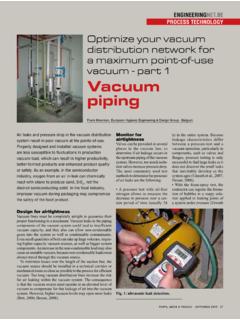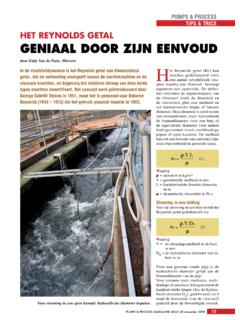Transcription of PUMP TECHNOLOGY Preventing your Vacuum …
1 pumps & process mAGAZINe - september TECHNOLOGYP reventing your Vacuum Pump from ContaminationVacuum pumps ingest whatever contaminants are transferred from the process to the pump inlet. The four primary inlet gas stream contaminants are vapours, liquids, solids, and biological and non-condensables on the Vacuum inlet need to either pass through the pumps (if they are non-damaging), or need to be condensed. To condense condensables into liquid, condensers or scrubbers are usually applied. The formed condensate is then drained. The presence of high condensable and non-condensable gas loads can significantly decrease the capacity of the Vacuum system. Even small quantities of both can take up large volumes. When a pump casing is full of liquid, the motor can become overloaded and the pump damaged. Moreover, if too much water vapours condense within the water ring pump, the temperature and hence the vapour pressure of the seal water will increase, giving rise to the sucked air contains too much water vapour and con-densables, a condenser is always required.
2 In that case, the Vacuum pump must not pass the condensate and the pump can be protected against too much condensate. A condenser in front of a water ring pump is also useful to decrease the temperature of the air entering the pump, which allows to control the temperature and the vapour pressure at the pump inlet within acceptable limits so that cavita-tion is not likely. Notice that sucked air at higher temperature also can contain more moisture. Condensers also prevent Vacuum pumps from excessive con-tamination by reducing solid and liquid carryover, and from excessive concen-tration of corrosive vapours in the load. It is a general recommendation that the condensers should be cold enough to condense the vapours generated by the application, and that they should be of sufficient size to remove condensed liquid. If there is a condenser, a knock-out pot is often no longer a requisite.
3 The Vacuum pump can then be installed immediately after the condenser (Aglitz et al., 1995; Croll, 1998).More than wet Vacuum pumps , dry Vacuum pumps cannot handle large amounts of water vapour or slugs of Fig. 1: combination knock-out pot inlet filter: 1. inlet, 2. outlet to Vacuum pump, 3. drain, 4. reservoir, 5. demister pad, 6. filter, 7. swing bolt, 8. hinge, 9. plugged connection, 10. sight glass, 11. level , because they will shut or slow down, and the Vacuum will be lost. Hence, a condenser ahead of the dry Vacuum pump is highly recommended to keep up with air containing large amounts of water vapour. That cold wall condenser prevents water vapour from entering and fouling the pump, and helps to lower the temperature of the air and gases drawn into the dry Vacuum pump. The latter action prevents the dry Vacuum pump from overheating (Myerson, 2000).When a steam ejector is used to produce the Vacuum , the same steam ejector can condense the water vapour as it is drawn along with the air from the Vacuum application.
4 Hence, a cold wall vapour condensor may not be needed except where a very high degree of efficiency is carryover can occur due to con-densation in the Vacuum pipeline lea-by Frank Moerman, MSc., European Hygienic Engineering & Design Group, Belgium, Pieter Van Hassel, Busch, Belgiumpumps & process mAGAZINe - september TECHNOLOGY ding to the pump, as the result of an upset condition, or along the exhaust system. That liquid may be responsible for a pump being stopped or damaged. The problem becomes even larger if this liquid product solidifies in the pump. These deposits can prevent the pump to restart, demanding for disassembly and retiming, or can be responsible for damage to the pump's rota-ting components, requiring replacement. To prevent that solid formation in the Vacuum pump, it is best to have a barometric con-denser, scrubber or trap that can remove these solidifying products from the vapour stream (Myerson, 2000).
5 To prevent liquid from getting into the Vacuum pump inlet, a knockout pot, a water trap or a cyclone liquid remover is used. The type of separator required will depend upon whether there are slugs of water or small droplets of liquid entrained in the vapor stream. Filtration is not an appropriate method to remove liquids from a Vacuum inlet gas stream, because they usually just clog and cake filter knock-out pot (Fig. 1) serves to filter out entrained liquid droplets, slugs of Fig. 2: cyclone liquid separator: 1. gas inlet, 2. gas discharge, 3. liquid drain, 4. cyclone, 5. baffle plate, 6. outlet tube, 7. collecting 3: liquid separator: 1. baffle plate, 2. demister, 3. baffle plate, 4. glass cylinder, 5. 3-way solenoid, 6. liquid collecting tank, 7. valve, 8. drain valve, 9. float switch, 10. controls1234576pumps & process mAGAZINe - september TECHNOLOGY liquid, aerosols, heavy mists and suspended solids from the Vacuum air stream, to pre-vent them from entering the pump inlet.
6 Sucked air that flows into the knock-out pot in a tangential way, can be stripped off these suspended solid particles and liquid. For that purpose, knock-out pots may have special shell side baffling to ensure minimal pressure drop, non-condensable gas cool-ing, and separation of non-condensables and condensate. Usually the knock-out pot is also provided with a demister (mist eliminator) which removes mist, fog and aerosols, and which also acts as a pre-filter removing larger solid particles. The hous-ing of certain knock-out pots is designed as a cyclone in the area of the gas inlet, sometimes provided with baffles to create supplementary turbulences, and a jacket through which a cooling medium is circu-lated. The tangential gas inlet and deflective cone force the incoming gas or vapour to flow along the vessel interior, decreasing their flow rate along the separating walls to give the condensables the time to con-densate, and to separate off liquids and coarse particles.
7 The stripped gases are then diverted towards a filter cartridge that acts as a demister or a pre-filter. Once passed through these filter cartridges, the cleaned gas exits the knock-out pot through the gas discharge (Busch, K. GmbH, 2010a). Cyclone liquid separators (Fig. 2) usu-ally have no cooling jacket and a demister. The gas medium that usually contains less condensables (most of them are already condensed in an up-stream condenser) is subjected to turbulence when sucked in the separator. The resulting centrifugal effect forces the liquid to the separating wall, where it then trickles down in droplet form to the collecting tank. The cleaned gas then leaves the cyclone through the outlet tube without passing a demister An alternative to cyclone liquid separators are liquid separa-tors that make use of a demister (Fig. 3). (Busch, K. GmbH, 2010b & c). Additional features are a collecting tank and condensate drain, sight glasses, high and low level switches and alarms, a lat-eral opening to clean the lower part of the knock-out pot, cyclone liquid separator or liquid separator with demister and a remo-vable top cover.
8 Removal of that lid makes it easier to inspect and clean the interior of the knock-out pot, and allows access to the filter cartridges (demister or fleece insert). Sometimes the final inlet filter to remove the smallest solid particles (10 m) is installed just above the all Vacuum pumping technologies have some degree of sensitivity to inlet particle contamination. Liquid ring, oil-lubricated rotary vane and all dry Vacuum pumps need a particle filter on the suction side, ahead of the Vacuum pump to protect the pump from considerable amounts of particle material and to extend its lifetime. Even in front of a steam jet ejector a dust inlet filter can be required, because in cer-tain Vacuum processes producing varying amounts of solid carryover, that solid can deposit inside the ejector system and plug up the diffuser throat. If the potential for deposits exists, it is appropriate to install the steam jet ejectors in such a way that they are easily accessible for cleaning (Birgenheier, 1993).
9 The expected service life of a Vacuum source comes down to how well it is pro-tected from incoming contamination. Fil-ters to protect a Vacuum pump in a particu-late environment against dust are available in many forms: paper filters, hydrophobic (water-resistant) synthetic fiber filters, fiber glass filter elements or metal mesh filters (Fig. 4). Metal mesh elements are more appropriate than paper and synthetic fiber disposable elements, because they are generally easy to clean, are resistant to clogging, can be wetted without blocking and can tolerate high gas temperatures. The filter must be capable to efficiently trap the particles in the size range being generated ( , dust extraction systems) (Busch, K. GmbH, 2010d).The filters should have at least the ability to retain 1-10 m large particles. For very small particulates, special media such as HEPA (high efficiency particulate air) or ULPA (ultra-low penetration air) filters may be required.
10 The particulate rate can be determined by calculating the volume of particulates per unit of time and by sizing the filter accordingly. It is also important to keep air flows below the recommended maximum velocity so that rated filtration efficiencies are maintained. To increase the lifetime and dust holding capacity, radial fine elements with extensive surface area (Fig. 4) can be applied. An example of a small dust separator is given in Fig. 5. For very large chamber systems and high dust loads, a multi-bag type filter should Fig. 4: different type of 5: small dust insertFilter cartridgesFiltering bagRadial fine polyester insertFleece/demister insertFleece insertReferences:Aglitz, J., Bhatnagar, R., Bolt, & Butzbach, (1995), Installing Liquid-Ring Vacuum pumps , Chemical Engineering, 102 (11), 132-138. Amos, D. & Bruce, S. (2005), Practical Vacuum : good design, procedures and maintenance equals good Vacuum , Industrial Heating, 72 (5), , Butzbach , Bolt , Bhatnagar , Ojala , Aglitz J.




